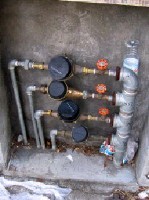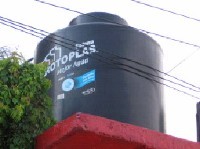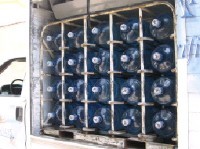“For many of us, water simply flows from a faucet, and we think little about it beyond this point of contact. We have lost a sense of respect for the wild river, for the complex workings of a wetland, for the intricate web of life that water supports.”
– Sandra Postel, Last Oasis: Facing Water Scarcity, 2003.
Global Water Availability
As seen from space, our earth is a wonderful blue and white marble-covered with water in the form of clouds and oceans. Yet, the perspective from the earth’s surface is that of lack. Less than 0.3% of the water on earth is available for human consumption, much of this being ground water. The earth’s fresh water supply is not distributed evenly, nor does it follow social or political boundaries. There are 213 rivers and 300 ground water sources that are shared by two or more countries.
Dr. Allan Hoffman of the US Department of Energy tells us that “global demand for water has more than tripled over the past half century” and further explains that the “largest user of fresh water is agriculture. … Over-pumping of ground water by the world’s farmers already exceeds natural replenishment by more than 160 km3….” In other words, we are in big trouble. He further tells us that:
The World Health Organization estimates that, globally, 1.1 billion people lack access to clean water supplies, and that 2.4 billion lack access to basic sanitation. 1,000 m3 is the per capita annual amount of water deemed necessary to satisfy basic human needs. In 1995, 166 million people in 18 countries lived below that level. By 2050, potable water availability is projected to fall below that level for 1.7 billion people in 39 countries. Water shortages now plague almost every country in North Africa and the Middle East.
There are significant health impacts of water shortages. Water-borne diseases account for roughly 80% of infections in the developing world. Nearly 4 billion cases of diarrhea occur each year.
Water Availability in Mexico
Mexico is no exception to this world crisis. Here, most water for human use seems to be extracted from aquifers through natural springs or wells, which are recharged largely by rainfall. The Centro Virtual de Información del Agua (The Virtual Center for Water Information) – known by the acronym CEVIA – reports that agriculture in Mexico comprises 77% of water use, industry 10% and municipal and domestic use 13%. Some 56% of Mexico’s land is comprised of arid and semi-arid ecosystems with limited rainfall and 72% of that rainfall evaporates back into the atmosphere. The northern states, which are the driest, make up 50% of the landmass but only receive 25% of the rainfall. Finally, major climactic changes seem to be at work in Mexico. One on-line source which did not include a date claimed that since 1994, it has rained less than the year before. In other words, water availability is also a problem in Mexico.
Water Distribution in Mexico

Water distribution is an issue in Mexico where building lots are often developed without basic resources such as electricity and water hookups. Many people live without running water and this means that they pay more for the water that they acquire. The web site www.drinkingwaterwisdom.com puts it poignantly, “As if being deprived of water were not enough, the poor people in developing countries pay up to 12 times as much for their water as their fellow citizens who are connected to municipal systems.” Others in Mexico receive water through some kind of pipe, but the water is insufficiently treated and not safe for human consumption. The availability of potable water in rural areas is cruelly scarce, while in most cities people still can’t drink their water. Those who can afford it must implement and pay for a variety of solutions to their “personal water problem,” such as buying bottled water, using colloidal silver drops, and installing filters at the inlet to their storage tanks or the outlets of their faucets.
Historically, towns and cities develop around springs or other water sources. As populations grow, people have to commit their resources to increasing their water supplies. Sadly, small towns in Mexico rarely have water treatment plants. More commonly, the smaller towns have small reservoirs about the size of a swimming pool where they store water from springs or streams. If the water is not potable for any number of reasons, that fact is accepted by the local people as status quo. People may or may not take measures to protect themselves.

In the tiny places called “ranchos,” an elected representative called the comisariado ejidal selects someone to be in charge of water. This person does the daily maintenance of the water distribution system such as opening valves to different parts of the rancho. When maintenance is required, he organizes residents into groups who either do the labor themselves or pay the cost of labor for someone else to do the work. Local water sources, such as nearby streams or springs are commonly used. Low tech infrastructures such as hand-built reservoirs with 2 inch black tubes leading to individual homes are common. Expectations for the quality of the water are low.
Mexico differs from the US in that there are almost no private wells. People who earn between $50 and $70 dollars a week can’t afford to pay someone to drill a well for their personal consumption. If the people of a rancho were to decide that they wanted a well, they would have to get the majority of the people to agree to the project. This would be a difficult process because some wouldn’t want to spend the money, some wouldn’t think it would make a difference, others would fear that their own water supply would be affected, etc., and consensus is hard to come by. Once reached, a proposal must be made to government officials in order to obtain their support. Obviously, this is rarely done.
Privatization of Drinking Water Distribution
To fill the need for safe drinking water, a number of private solutions have developed.
Mexico is one of the world’s largest consumers of bottled water. Many businesses bottle and deliver water to stores and residences in Mexico. Prices are controlled by the conditions of the local market. Factors such as relative supply and demand and competition among companies determine the local price.
As an example, let’s look at Cuernavaca. Here laborers earn $700 pesos per week and the 20-liter bottles of water, known as garrafones, cost around $21 pesos. If everyone in a family of five were to drink two liters of water per day (this does not include hand washing, tooth brushing, etc.), they would go through 70 liters or 3.5 garrafones per week at a cost of $74 pesos. The family would have to spend over 10% of their income on potable water. Since $700 pesos per week is really too little to cover the costs of a family, realistically, bottled water is out of reach of most Mexicans.

For those who do have money, bottled water is easy to find and purchase. Travelers can buy water by the liter in any of the small abarrotes stores found on practically every corner in Mexico. The standard cost for a liter of bottled water is $6 to $8. In restaurants or places that cater to tourists, half-liter bottles sell for $10 to $15 pesos. For those who wish to save money on water as they travel, 5 and 10 liter bottles of water can be purchased in some larger stores.
Expatriates, who generally have higher expectations for their drinking water than their Mexican counterparts, can purchase garrafones for use in their homes. In some cities, these are delivered to your door. In other cities, you have to be ready to run out the door and flag down a water truck as it passes your house. Carrying the extremely heavy water containers can be hazardous or impossible for many people. Those for whom garrafones aren’t the right solution have to consider some kind of filter or treatment that can be done to the municipal water at their house.
Drinking Water for Children
The San Pablo Mission in Cedros, Jalisco is home to HIV-negative children whose parents have died of AIDS. But their most pressing need is water. Orphanage staff has decided that the best way to supply this need is to dig a well, but they don’t have the money to complete this project. Recently, a group of teens from the Holy Innocents parish in Pleasantville, New York visited the home.”We took toys and necklaces for the children…. But when I walked into the orphanage, a small girl named Chita took my water bottle and started to drink the water as fast as she could, sharing it with her friends,” says Kerrie Lopez, president of the parish Catholic Youth Organization. These young people from New York grew up with tap water that runs 24/7 and couldn’t have imagined that an orphanage could even exist without water. The group has been able to raise $16,000 toward the well. Water is a basic human need and these youths can be proud of helping improve the water distribution situation for some deserving children in Mexico.
“When the well’s dry, we know the worth of water.”
– Benjamin Franklin, (1706-1790), Poor Richard’s Almanac.
